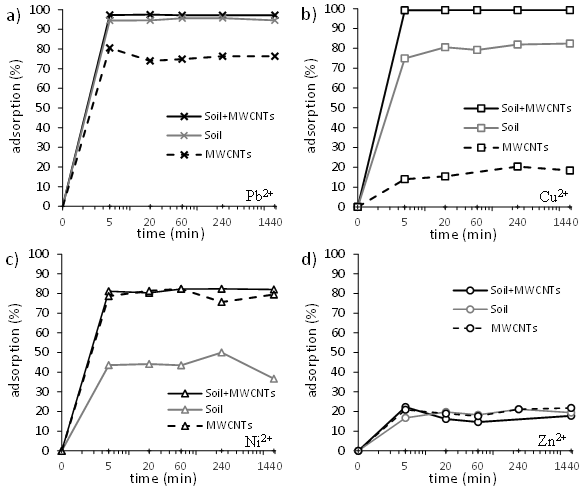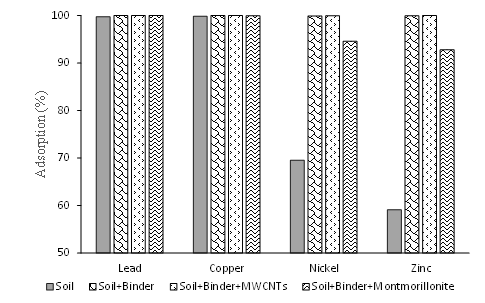This experimental work assessed the efficiency of different additives (MWCNTs, montmorillonite and Portland cement) to immobilize the heavy metals lead, cooper, nickel and zinc in a soil in conditions similar to a real case scenario (percolation tests).
- contaminated soil
- heavy metals
- montmorillonite
- carbon nanotubes
- Portland cement
- percolation tests
1. Introduction
Since heavy metals (HMs) are not biodegradable and cannot be destroyed through high temperatures or the use of chemicals, ordinary soil remediation techniques are ineffective. One of the most promising techniques to immobilize heavy metals consists of mixing additives with the soil with the objective to reduce the potential migration of HM and thus the risk of contaminating adjacent areas.
2. Experimental procedure
The soil was artificially contaminated with the HMs (lead, copper, nickel and zinc), and suspension adsorption tests were carried out to evaluate the adsorption capacity of the additives (CNTs and clay mineral). Percolation tests were then conducted to better evaluate the efficiency of CNTs, clay mineral, and Portland cement to immobilize the HMs tested, in the soil, in conditions similar to a real on-site situation. Leaching tests were also performed in order to verify if CNTs (the nanomaterial used) are not being released in the environment.
3. Results
The results allow to conclude that the additives, carbon nanotubes and montmorillonite , have the potential to minimize HMs mobility in contaminated soils and can be a valid alternative to the usual additive, Portland cement, when tested in conditions similar to a real on-site situation. Moreover, the study revealed that even if the adsorption tests are a valid tool to evaluate the performance of the additives, only percolation tests can take in consideration the influence of the soil’s properties, reproducing in a better way the conditions of a real field situation.
Since all the options studied in this work revealed to be technically efficient in the immobilization of HMs in soils, the designers’ and decision-makers’ choice of the best additive will depend mainly on the environmental-economic compromise.
Figure 1. Results from the adsorption tests. Individual adsorption of lead (a), copper (b), nickel (c) and zinc (d) by the soil, MWCNTs and suspension of soil with the addition of MWCNTs.
Figure 2. Results from the percolation tests. Immobilization of heavy metals by the soil, the soil with Portland cement and the soil with Portland cement with MWCNTs/montmorillonite.
Full text: https://www.mdpi.com/2076-3417/10/22/7950 or Appl. Sci. 2020, 10, 7950; doi:10.3390/app10227950


